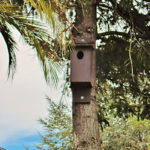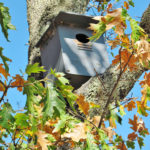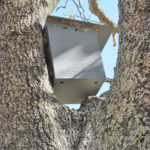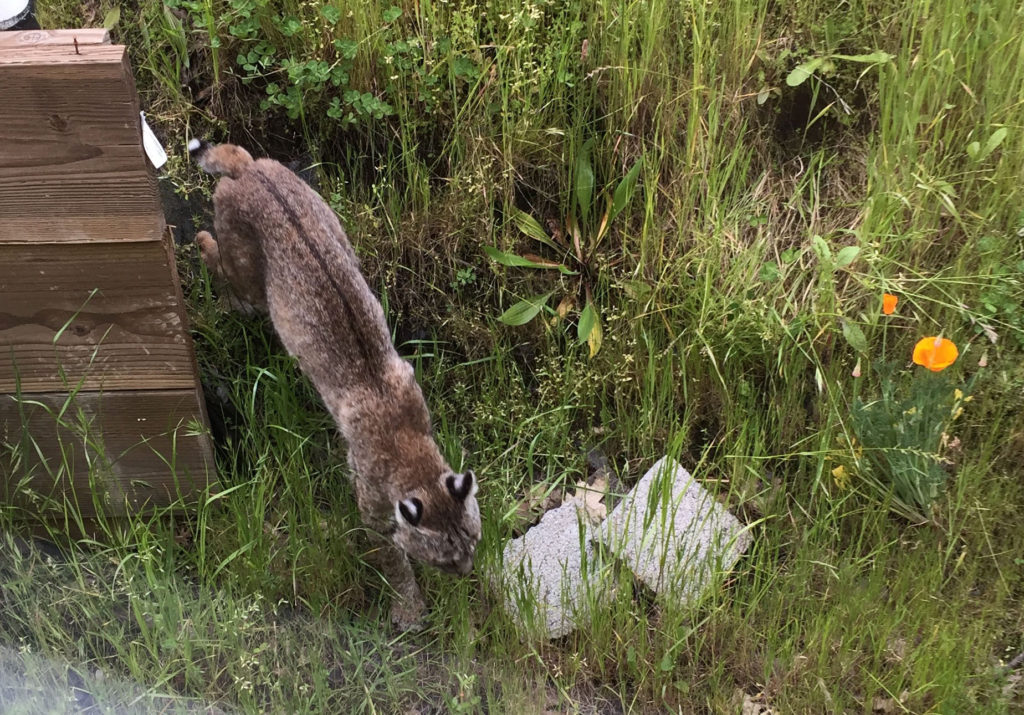
Wildlife Stories
Deer floating across the hills, coyotes walking up the street as if they own it, not to mention choruses of birds and frogs; this is the place to share your wildlife stories and find out more about the creatures who share our valleys.
Coyotes
 Enjoying the singing coyotes on our hillsides and wetlands? Learn more about coexisting with them here. Enjoying the singing coyotes on our hillsides and wetlands? Learn more about coexisting with them here.
Wild Turkeys
Here are a couple of enlightening articles about living with wild turkeys from species management and from houzz forum comments at “Any experience with wild turkeys and gardening?”
Orange-and-Black Hooded Orioles
Watch for the orange-and-black Hooded Orioles nesting in the palm trees. Former resident Bill Noble says, “Each year, the female slips under a palm frond and stitches her woven nest to its hidden underside.”
Owls
  
If you live on the slopes of the hill coming down into the Park, you’ve heard the owls courting in the evenings near the owl boxes HOL (starring Dee Schneider) has put up over the years. Looking forward to a new generation of rodent control; no poison needed!
Wildlife Protection from Pesticides
Tired of hearing scratching and nibbling sounds under your home? Now is the perfect time to investigate and repair points where wild animals might be living with you. WildCare has an excellent, easy-to-follow 24-point self home inspection guide Wildcare_How_to_Effectively_Prepare_Your_Home. And this article by former resident Susanne Dyby could make you swear off using pesticides forever E_toxicus_unum.
Ways to live with wildlife from WildCare “Living with Wildlife.”
One more reason from WildCare not to use pesticides: “Rat Poisons Killing Hawks, Owls and Others“
Bobcats in Springtime!

Lee Pochapin caught a pic of this one in April of 2017 out behind his home: May 2018: Janita Reynolds writes, FACE TO FACE WITH A BOBCAT ON MEADOW VIEW! It was 5 pm in my back yard. About 15 feet apart. He/she froze, I froze, and we stared at each other for about 6 seconds. Then he sauntered off down the street. He was beautiful! I guess he read my garden sign that says it’s a certified wildlife habitat….. Those of you who let your pets loose outside – be aware.
May 2017: Anila Manning writes, At 8:30 this evening I was walking down Marin Valley just west of the Clubhouse and spotted an animal standing on the sidewalk about 50 feet ahead of me. It started walking toward me with a fluid feline walk, and when it turned toward a trail through the junipers I could see the lack of a long tail. It was getting dark, and it was dark colored, so couldn’t see any markings. But it was tall! About up to my knees and a couple of feet long, very slender, like the one Lee took a pic of.
I felt no danger from this one; it clearly wasn’t interested in me. I’m happy to live and let live. The traditional advice is, make noise and it will run away. “Should you encounter a bobcat, keep as much distance between you and the animal as possible: Immediately protect children and pets; Back away from the bobcat slowly and deliberately; Avoid running away because that could trigger a pursuit response; If possible, spray the animal with water; When possible make a lot of noise (banging pans, for instance, or blowing an air horn).
Here’s more: “A healthy bobcat seldom attacks a human. In fact, according to the Arizona Game and Fish Department’s Internet site, ‘Bobcats are not considered a threat to human safety except in rare cases when they have rabies or are extremely aggressive.’ They are generally shy and fade away into the bushes unless they’re rabid (literally foaming at the mouth and either are lethargic or erratic, in which case you need to call the Humane Society). “Bobcats can pose a serious threat to pets, especially those that run freely in yards with native plant gardens, substantial wildlife, shelter, shade and water – and bobcats can be surprisingly bold around homes in rural areas.” “Though the bobcat prefers rabbits and hares, it hunts insects, chickens, geese and other birds, small rodents, and deer. It keeps on the move from three hours before sunset until about midnight, and then again from before dawn until three hours after sunrise. Each night, it moves from 2 to 7 mi along its habitual route. “The average bobcat lifespan is 7 years long and rarely exceeds 10 years. “The female raises the young alone (insert snarky comment of choice here). One to six, but usually two to four, kittens are born in April or May, after roughly 60 to 70 days of gestation. Sometimes, a second litter is born as late as September. The female generally gives birth in an enclosed space, usually a small cave or hollow log. The young open their eyes by the ninth or tenth day. They start exploring their surroundings at four weeks and are weaned at about two months. Within three to five months, they begin to travel with their mother. They hunt by themselves by fall of their first year, and usually disperse shortly thereafter.” It’s been hunted in various parts of the US, but the pelts aren’t worth much these days, you have to buy hunting tags, and can kill no more than 5/season, which is October through February. “Grave artifacts from dirt domes excavated in the 1980s along the Illinois River revealed a complete skeleton of a young bobcat along with a collar made of bone pendants and shell beads that had been buried by the Hopewell culture. The type and place of burial indicate a tamed and cherished pet or possible spiritual significance.”
Poisonous Plants
“My vet asked me to compile a table of really poisonous plants, because he recently and sadly lost a puppy from a client who owned a sago palm. She did not react soon enough (not because she was not concerned, but because she did not realize the danger as soon as it happened) and one of two puppies died. This is a table without photos and people will have to look up pictures on their own. There are other very very poisonous plant species, like water hemlock, Datura (Angel’s trumpet), jimson weed, and pokeweed that are not yet included in the table, either because the plants are more likely to be eaten by livestock or, in the case of Datura, it does not seem to attract attention even from the most curious of cats and dogs.
“I figure this may be a good thing to post, given that a lot of people either have grandkids or pets. I have compiled the table REALLY_POISONOUS_PLANTS from public resources. Best wishes, Susanne” |